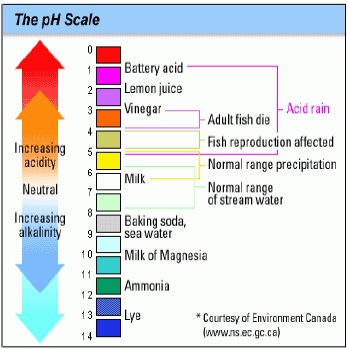 The pH of a substance is a measurement (color change or number change) of how much acid or base a substance may contain. Many acids and bases are important to the internal chemical reactions that take place in living things. Most living things attempt to keep themselves at equilibrium (neutral), but this is sometimes very difficult due to the pH of the surrounding environment. The pH scale (the measure of acids and bases) ranges from 0 to 14, with 7 being the middle or neutral point. A substance with a pH of less than 7 is acidic and if it greater than 7 it is basic, also called alkaline. Each time there is a change in pH of one unit, it is the same as multiplying ten times (increase or decrease) the strength of the acid or base. Litmus paper is one way to measure the strength of an acid or base substance. Other ways include, electronic pH meters and test kits that will measure acids and bases by comparing color scales.
The pH of a substance is a measurement (color change or number change) of how much acid or base a substance may contain. Many acids and bases are important to the internal chemical reactions that take place in living things. Most living things attempt to keep themselves at equilibrium (neutral), but this is sometimes very difficult due to the pH of the surrounding environment. The pH scale (the measure of acids and bases) ranges from 0 to 14, with 7 being the middle or neutral point. A substance with a pH of less than 7 is acidic and if it greater than 7 it is basic, also called alkaline. Each time there is a change in pH of one unit, it is the same as multiplying ten times (increase or decrease) the strength of the acid or base. Litmus paper is one way to measure the strength of an acid or base substance. Other ways include, electronic pH meters and test kits that will measure acids and bases by comparing color scales.
Tools and things you will need
- Baking soda
- Blender
- 5 x 8 index card
- Eye dropper
- Lemon juice
- Red cabbage
- Strainer
- Vinegar
- A plastic sheet to contain the mess.
Hint: Lemon juice and vinegar are acids and should turn the paper pink (lower pH). Baking soda is a base and should turn the paper green (higher pH). If there are no color changes with your test liquids, this means they are neutral.
What to do?
- Pull off the cabbage leaves.
- Press them down hard on the white card until the card turns purple (6th grader Peter Cable discovered that the purple in the leaves works the best).
- When you have turned the whole card purple, put a drop of each test substance on the card.
More things to do
For these steps you'll need a blender and adult supervision)
- Cut cabbage into chunks.
- Blend the cabbage chunks into a blender until liquid.
- Strain the contents of the blended cabbage with the strainer.
- Mix a drop of this liquid with the substance being tested.
[
Learn more... ]